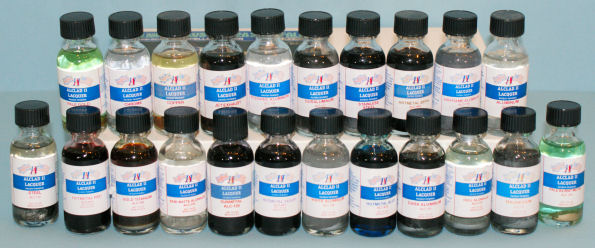
Alclad II Polished Brass, Exhaust Manifold, Burnt Iron First-Look
By Michael Benolkin
| Date of First Look | May 2010 | Manufacturer | Alclad II |
|---|---|---|---|
| Subject | Alclad II Polished Brass, Exhaust Manifold, Burnt Iron | Pros | Hard finish, can be painted over, masked, and handled w/o fingerprints! |
| Cons | Lacquer-based finish, requires good ventilation | MSRP (USD) | $8.25 per 1 oz. bottle |
First Look
In the mid-1990s, a product appeared on the hobby shop shelves that revolutionized bare metal modeling. This product, called Alclad, made itself known at the 1995 IPMS/USA National Convention on an AMT/ERTL 1/72 XB-49 Flying Wing painted with different shades of this new metalizer. What made Alclad different from other products on the market:
- It came in a variety of 'shades' of aluminum, as well as steel, titanium, etc.
- It could be applied over other paints
- It could be masked and sprayed over
- It could be handled without fear of fingerprints!
Alas, as fast as Alclad appeared, it went out of production again when the company closed. It forced many of us to hoard our remaining supplies of Alclad and otherwise shelve any new bare metal projects until something new came along.

Last month, we looked at the Alclad II metalizer range ( look here) and even created a metalizer reference chart here.
We've just received three of their latest metalizer shades:
- Polished Brass
- Exhaust Manifold
- Burnt Iron
The exhaust manifold is not actually a metalizer of its own, rather it is one of several shades inteded to be oversprayed over any of the other metalizers to recreate the heat-induced look of exhaust manifolds, exhaust pipes, etc.
The polished brass and burnt iron provide additional metalizer shades into this already impressive line-up. The line-up includes:
- ALC-101 - Aluminium (Aluminum if you prefer)
- ALC-102 - Duraluminium
- ALC-103 - Dark Aluminium
- ALC-104 - Pale Burnt Metal
- ALC-105 - Polished Aluminium
- ALC-106 - White Aluminium
- ALC-107 - Chrome for Plastic
- ALC-108 - Pale Gold
- ALC-109 - Polished Brass
- ALC-110 - Copper
- ALC-111 - Magnesium
- ALC-112 - Steel
- ALC-113 - Jet Exhaust
- ALC-114 - Chrome for Lexan
- ALC-115 - Stainless Steel
- ALC-116 - Semi-Matt Aluminium
- ALC-117 - Dull Aluminium
- ALC-118 - Gold Titanium
- ALC-119 - Airframe Aluminium
- ALC-120 - Gunmetal
- ALC-121 - Burnt Iron
- ALC-123 - Exhaust Manifold
- ALC-401 - Transparent Red
- ALC-402 - Transparent Yellow
- ALC-403 - Transparent Blue
- ALC-404 - Transparent Green
- ALC-405 - Transparent Black/Smoke
- ALC-411 - Hot Metal Red
- ALC-413 - Hot Metal Blue
- ALC-416 - Hot Metal Sepia
- ALC-417 - Hot Metal Violet
One of the first major differences between the original Alclad and Alclad II is that Alclad II should be applied over a coat of acrylic primer. The lacquer will evidently craze softer plastics. I tried the Alclad II straight onto the nozzle of a Hasegawa F-16 and had no reaction without primer. When all else fails, however, follow the instructions.
The Highly Polished Aluminium must be applied over a gloss black acrylic to be effective, while Chrome must be applied over a gloss black enamel. These are currently the only two shades requiring special attention.
As you can see in this photo, there are a wide variety of metal colors here as well as the transparent overlays. Some of these transparent and hot metal colors are ideal for replicating scorched metal around afterburner sections.
All of these products are airbrush ready (they're too thin for brush application) and you will need a good spray booth or have ample ventilation with a good breathing mask/filter to protect your lungs. Once you get your Alclad II properly mixed and your airbrush loaded, you'll be pleasantly surprised how little it will take to obtain good coverage on your model.
My sincere thanks to Alclad II for these review samples.







